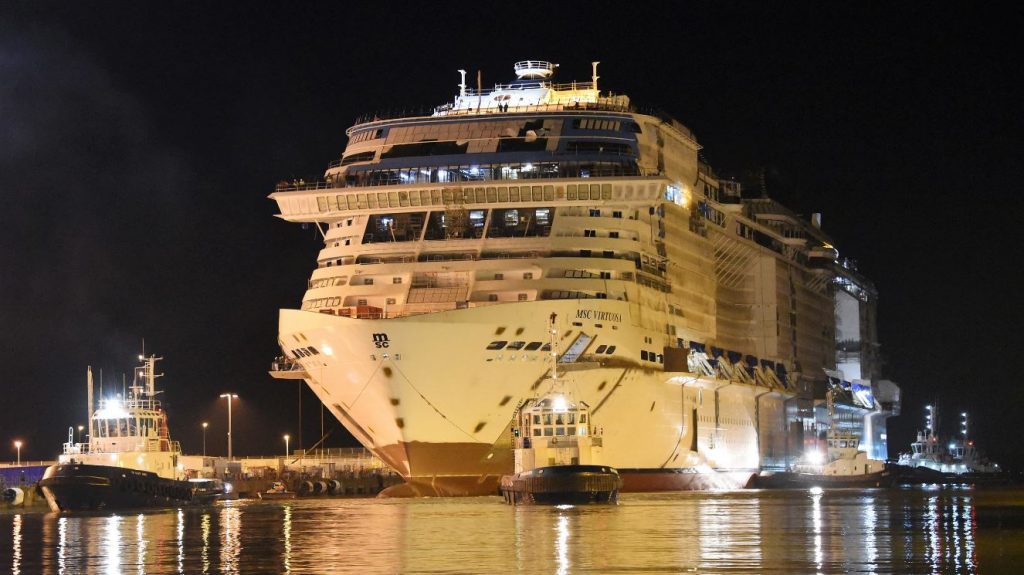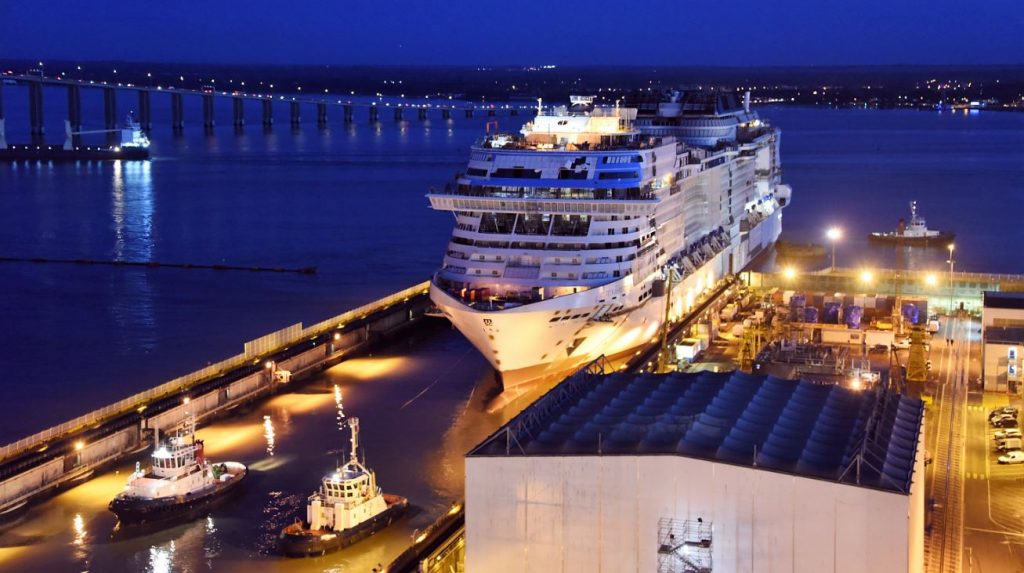MSC Cruises last weekend celebrated the float out of MSC Virtuosa. The float out marks the third major new ship building milestone the company has celebrated in the past month.

Last weekend’s float out of MSC Virtuosa at the Chantiers de l’Atlantique shipyard in Saint-Nazaire, France follows the successful delivery of MSC Grandiosa as well as the steel cutting ceremony of MSC Europa, the cruise line’s first of five liquified natural gas (LNG)-powered ships, on October 31st.
At the time MSC Cruises also unveiled a ground-breaking R&D project in conjunction with Chantiers de l’Atlantique named PACBOAT. The R&D project will focus on the integration of a new fuel cell technology, especially relevant for cruising, on board the LNG-powered MSC Europa. The line said it was committed to contribute to the development of next-generation advanced environmental technology for the benefit of its own environmental stewardship journey and that of the entire cruise industry.
MSC Grandiosa was christened in Hamburg the following week on 9 November. The company also announced that from 1 January 2020 it will become the world’s first fully carbon neutral major global cruise line. MSC Cruises will offset all direct carbon dioxide (CO2) emissions from its fleet marine operations through a blend of regular and blue carbon offset projects developed according to the highest standards by leading international entities that take immediate action on greenhouse gas emissions.
MSC Cruises added that while it recognised that today’s most advanced maritime environmental technology alone is insufficient to reach carbon neutrality immediately, the line would continue to invest in the accelerated development of advanced environmental technology to eventually achieve its zero-emissions commitment from operations alone.

MSC Virtuosa will be the second Meraviglia-Plus ship after MSC Grandiosa and will now move to a wet dock for further construction and fitting until she is delivered in October 2020. The sixth MSC Cruises ship to enter service since 2017, MSC Virtuosa will be as highly equipped as MSC Grandiosa with cutting-edge technologies and the second ship in the Company’s fleet to have a selective catalytic reduction (SCR) system and next-generation advanced wastewater treatment system (AWTS) to minimise her environmental footprint and ensure ever cleaner air emissions.
MSC Virtuosa’s SCR will help reduce nitrogen oxide by 80 per cent with the technology converting it into harmless nitrogen and water. She will also be equipped with a next-generation AWTS to treat wastewater to a very high quality and the end product is of a better standard than most land-based municipal waste standards around the world. MSC Virtuosa will also be fitted with shore-to-ship power which connects a docked cruise ship to a port’s local power grid to further reduce air emissions. This feature is broadly available across MSC Cruises’ entire fleet and has been standard across all of the Company’s new ships since 2017.
These features add to other effective environmental technologies deployed on MSC Virtuosa and across the rest of MSC Cruises’ fleet to minimise and continuously reduce a cruise ship’s environmental impact, including: cutting-edge hybrid exhaust gas cleaning systems that remove sulphur oxide from ship emissions by up to 97 per cent; advanced waste management; ballast water treatment systems; latest-technology systems for the prevention of oil discharges from machinery spaces and various state-of-the-art energy-efficiency improvements – from heat recovery systems to LED lighting.
MSC Virtuosa’s maiden voyage will be a 7-night six-port Western Mediterranean cruise in November 2020 from Genoa, Italy. After a winter season in the Med, MSC Virtuosa will be deployed in summer 2021 to Northern Europe with itineraries to the Norwegian fjords and Baltic capital cities.